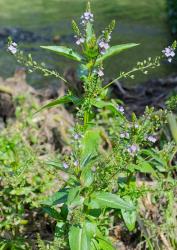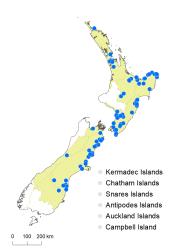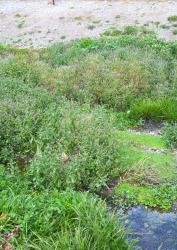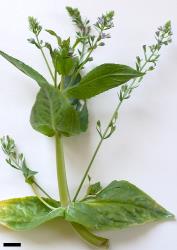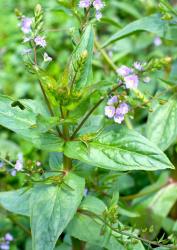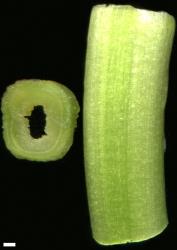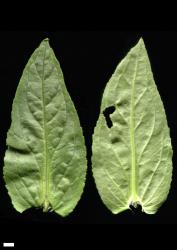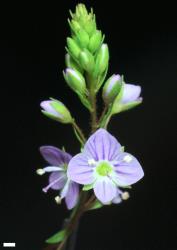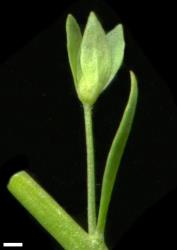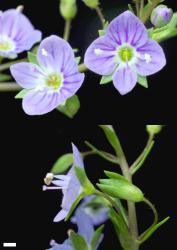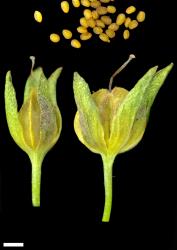- Taxon
- Gallery
- = Veronica anagallis Tate (1885)
Perennial herb to 0.9 m tall. Stems creeping at first, later erect (stout, succulent and hollow, with adventitious roots at nodes that are in contact with soil or submerged), glabrous. Leaf bud indistinct; leaves separating while small, opposite-decussate, erecto-patent to spreading or reflexed; lamina thin, elliptic to obovate or oblong or oblanceolate, lanceolate and membranous if submerged, 30–85 mm (rarely to 150 mm) long, 10–40 mm (rarely to 75 mm) wide, dull pale green to green above, dull pale green beneath; midrib and lateral veins evident; surfaces glabrous; margin glabrous, minutely toothed to serrulate, rarely entire; teeth in 10–40 pairs; apex acute to acuminate; base cordate, amplexicaul and sessile, or the lower to mid leaves cuneate to petiole 2–5 mm long. Inflorescence a lateral raceme, 50–200 mm long; flowers crowded at first, becoming distant, 10–80, all bisexual; bracts alternate, linear, usually about ½ as long as pedicels or rarely about equal; pedicels erecto-patent to spreading, usually incurved at fruiting, 2.5–5.0 mm long at flowering, 5–8 mm long at fruiting, glabrous or rarely with sparse glandular hairs all around. Calyx lobes 4, acute to acuminate, 1.8–2.5 mm long at flowering, up to 4.5 mm long at fruiting, sub-equal, glabrous. Corolla 5–7 mm diameter; tube yellow and white, c. 0.5 mm long, < calyx, eglandular hairy inside; lobes 4, pale blue, mauve, or pink, spreading, unequal, broadly ovate, orbicular, or broadly rhomboid, 2.5–3.0 mm long, obtuse; nectar guides magenta or purple, on all lobes. Stamens white, mauve, or pink, filaments 1.5–2.5 mm long; anthers white, pink, or mauve. Style glabrous, 1.5–2.5 mm long. Capsules angustiseptate, truncate to shallowly emarginate, glabrous or sparsely glandular ciliate on margins, 2.8–3.8 mm long, 2.5–4.0 mm at widest point. Seeds ellipsoid or oblong, flattened on face, rounded on back, smooth, pale brown or brown, 0.5–0.6 mm long.
V. anagallis-aquatica plants are most likely to be misidentified as V. americana and V. catenata; they are all glabrous or almost glabrous aquatic plants and their seeds have an excentric chalaza. V. americana plants differ by solid stems and by leaves that are all shortly petiolate, even the uppermost, and more coarsely toothed. In V. anagallis-aquatica, at least the leaves that subtend inflorescences are sessile. V. americana plants also have shorter inflorescences (80–170 mm long) with fewer flowers (10–27), longer pedicels 7–14 mm long, larger and darker flowers (7–10 mm diameter), longer styles (3.5–4.0 mm long), and completely glabrous capsules that are a bit smaller (3.0–4.0 × 3.0–4.3 mm). V. catenata plants differ in their sparsely glandular inflorescences, bracts being nearly always slightly longer than the pedicels, rather blunter calyx lobes, smaller pink flowers with the corolla tube glabrous or sparsely hairy within, glossier and darker green leaves, and emarginate capsules that are broader than their length.
Plants of a fourth aquatic species, V. scutellata, are very slender and weak-stemmed, with very narrow leaves and filiform inflorescences that are only one at each node; their deeply emarginate or didymous capsules are larger and distinctly flattened, and their seeds are 1.2–1.4 mm long with a central chalaza.
North Island: throughout.
South Island: throughout but not recorded from Western Nelson and Southland.
River banks, shores of lakes and pools, ditches, drains, swamps. Recorded elevations range from 0 to 420 m.
Hooker (1852–1853, p. 197, as V. anagallis L.). Voucher: not located.
Flowers: all year, but mostly spring and summer; fruits: all year.
2n = 36 based on overseas counts (Albach et al. 2008).
Veronica anagallis-aquatica is classified in V. subg. Beccabunga (Albach et al. 2004; Albach & Meudt 2010), along with similar aquatic species V. americana and V. catenata, and also V. peregrina and V. serpyllifolia. The species has also been recorded in New Zealand as V. anagallis.



